Table Of Content

It's like wanting to divide a bag of jelly beans equally between your friends, but you can't quite do it perfectly. Think of this one as the cool cousin of True Experimental Design. It wants to be just like its famous relative, but it's a bit more laid-back and flexible.
Quasi-Experimental Design
By changing multiple inputs at the same time, DOE helps to identify important interactions that may be missed when experimenting with only one factor at a time. We can investigate all possible combinations (full factorial) or only a portion of the possible combinations (fractional factorial). The molecular biology techniques used to assemble and transform the payload, the host strain details and growth conditions, such as temperatures and times, could also influence expression. How precisely you measure your dependent variable also affects the kinds of statistical analysis you can use on your data.
Design of complex neuroscience experiments using mixed-integer linear programming - ScienceDirect.com
Design of complex neuroscience experiments using mixed-integer linear programming.
Posted: Wed, 05 May 2021 07:00:00 GMT [source]
DOE implementation with a practical example: 7 elements to consider

Repeated Measures design is also known as within-groups or within-subjects design. We can see three main reasons that DOE Is a better approach to experiment design than the COST approach. So, for example, first we might fix the pH at 3, and change the volume of the reaction container from a low setting of 500ml to a high of 700ml. Michael Sadowski, aka Sid, is the Director of Scientific Software at Synthace, where he leads the company’s DOE product development. In his 10 years at the company he has consulted on dozens of DOE campaigns, many of which included aspects of QbD.
One factor at a time (OFAT) method
Imagine that we want to optimize the expression of a target protein in bacterial cell culture. Here we predict that increasing temperature will increase soil respiration and decrease soil moisture, while decreasing soil moisture will lead to decreased soil respiration. As you can already tell, OFAT is a more structured approach compared to trial and error. Let’s say two baseball coaches are training their players in two completely opposite ways. One coach is training the first string players in traditional ways, the other coach is using new training programs of various countries to train the second string players. This allows for a more efficient use of resources, as you're only continuing with the experiment if the data suggests it's worth doing so.
With three two-level factors, eight experiments will be required, and there will be four replicates of each level of each factor, further increasing the precision of the result. There will be three two-factor interactions and a three-factor interaction to evaluate. Usually, interactions involving three or more factors are not important and can be disregarded. Medical researchers have long understood the importance of carefully designed experiments. These techniques, however, have not been applied as rigorously in the product and design phases as in the clinical evaluation phase of product development. The recent focus by FDA on process validation underscores the need for well-planned experimentation.
Despite these challenges, longitudinal studies have been key in fields like psychology, sociology, and medicine. They provide the kind of deep, long-term insights that other designs just can't match. "It is the spirit of variable design and flexibility that drove us to create FS Industrie," he adds. "A response to the changing nature of type, for brands that are responding to the changing nature of work."
The variable the experimenter manipulates (i.e., changes) is assumed to have a direct effect on the dependent variable. To assess the difference in reading comprehension between 7 and 9-year-olds, a researcher recruited each group from a local primary school. They were given the same passage of text to read and then asked a series of questions to assess their understanding. Plus, we will we have support for different types of regression models. For example, we can estimate what we call a linear model, or an interaction model, or a quadratic model.
Steps involved in Experimental Research Design
The more levels that are identified for each factor, the more trials will be required to test these levels. To ensure that an optimal number of levels are selected, focus on a range of interest. This range includes settings used in the normal course of operations and may also include settings of more extreme scenarios. The greater the difference in factor levels, the easier it becomes to measure variance. It allows manipulating multiple input factors and determining their effect on a desired output (response).
Experiment Design Guidelines for Product Analysts — Part 1/3 - ResearchGate
Experiment Design Guidelines for Product Analysts — Part 1/3.
Posted: Mon, 21 Jun 2021 07:00:00 GMT [source]
Imagine if all the professional-level players ended up on one soccer team and all the beginners on another; that wouldn't be a very informative match! Covariate Adaptive Randomization fixes this by using important traits or characteristics (called "covariates") to guide the randomization process. In traditional randomization, participants are allocated to different groups purely by chance. This is a pretty fair way to do things, but it can sometimes lead to unbalanced groups. Picture a soccer coach trying to create the most balanced teams for a friendly match.
The study of the design of experiments is an important topic in metascience. The principle is that even when the same treatment is used in other experiments, the output would differ. Replication in experimental design helps to study the variation in the yield of different experiments.
His work helped create the foundations for a more organized approach to experiments. Fast forward to the Renaissance (14th to 17th centuries), a time of big changes and lots of curiosity. People like Galileo started to experiment by actually doing tests, like rolling balls down inclined planes to study motion.

No comments:
Post a Comment